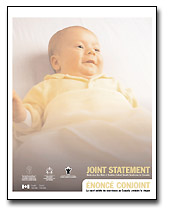Common menu bar links
Institutional links
Diseases & Conditions
Health & Safety
Research & Statistics
Agency Information
Search Box
E-mail this page
Sudden Infant Death Syndrome (SIDS)

Joint Statement
Sudden Infant Death Syndrome (SIDS) refers to the sudden and unexpected death of an apparently healthy infant usually less than one year of age, which remains unexplained even after a full investigation. On average, 3 infants a week are reported to die of SIDS in Canada. Although in Canada there has been a decrease in the number of infant deaths reported as SIDS, it still remains a significant public health concern. Aboriginal infants have a risk of SIDS that is higher than the risk to non-Aboriginal infants.
Although the specific cause of SIDS remains unknown, we do have some knowledge of certain risk factors. The Canadian Foundation for the Study of Infant Deaths, the Canadian Institute of Child Health, the Canadian Paediatric Society and Health Canada held a workshop in 1993 on reducing the risk of SIDS. Experts presented and discussed evidence that babies who usually sleep on their tummy (prone position) have an increased risk of SIDS compared to babies who sleep on their back or side. Over the past several years, evidence has emerged that babies who sleep on their back have the lowest risk for SIDS. Many studies report that when there was a decrease in the use of the prone sleeping position, there was also a decrease in SIDS deaths.
For sleep, we recommend that normal, healthy infants be placed on their back.
It is important to assure parents and caregivers that normal, healthy babies do not choke or have any other problems resulting from sleeping on their back, even when newly born and still in the hospital. However, there are certain health conditions that do require the tummy-down sleeping position. Parents should discuss their baby's particular needs with their doctor.
When infants are awake, some "tummy time" is necessary for developmental reasons. This will also avoid temporary flat spots that may develop on the back of their head.
Older infants may be able to turn on their own from their back to their tummy. It is not necessary to force the back sleeping position on a baby who has enough mobility to find a comfortable position.
Bedsharing is a common practice for many families. There is no evidence that an infant sharing the bed with a parent or sibling has a reduced risk of SIDS. The risk of SIDS is increased if the person who shares the bed is a smoker, or has been consuming alcohol or taking other drugs that may decrease their responsiveness.
Maternal smoking during pregnancy or exposure to Environmental Tobacco Smoke (ETS*), or both, are significant risk factors. An infant who has been exposed either before or after birth is placed at an increased risk for SIDS compared to those infants who have not been exposed.
Some studies have suggested that using certain drugs or substances during pregnancy such as marijuana, crack, cocaine and heroin, as well as binge drinking, may increase the risk of SIDS. Use of these substances should also be avoided while breastfeeding.
We recommend that all infants be cared for in a smoke- and drug-free environment.
Research provides evidence that babies who become too hot have an increased risk of SIDS. However, care must be taken in applying these results to Canada, as our climate and child care practices differ. It is important for parents to know that while infants need warmth and protection from the Canadian elements, they also should not become too hot. Parents can be reassured that if a room temperature is comfortable for them, it is most likely fine for their infant, too.
We recommend that infants be dressed and covered in a manner to avoid overheating, even during an illness.
Breastfeeding has significant nutritional, immunological and psychological benefits for the health of infants and may help protect against SIDS.
We recommend that all women be encouraged and helped to breastfeed their babies.
Parents and caregivers should avoid certain products in an infant's sleeping environment. SIDS can be difficult to distinguish from suffocation, and the following recommendations will also reduce the risk of smothering. Do not use soft mattresses or soft bedding such as pillows, comforters, bumper pads and lambskin or similar products. Although there are devices sold to maintain infant sleeping positions, there is no evidence that such products are beneficial in reducing the risk of SIDS. Objects that prevent circulation of fresh air around a sleeping infant's face such as stuffed toys, manufacturer's plastic wrapping and other plastic wrap products should also be avoided.
Commercial home apnea monitors for infants are available. However, there is no conclusive evidence supporting the effectiveness of such devices to reduce the risk of SIDS.
We recommend that firm flat bedding be used for normal healthy infants, with sheets and light blankets as needed, but without products to maintain the sleeping position.
Since the cause or causes of SIDS remain unknown, parents who have lost a child due to SIDS should not conclude that their child care practices caused their baby's death. It is important to emphasize that research can only tell us how to reduce the risk of SIDS.
The Canadian Foundation for the Study of Infant Deaths, the Canadian Institute of Child Health, the Canadian Paediatric Society and Health Canada have integrated this information into existing programs and will continue to do so. There are several strategies to disseminate this information to the public and to health professionals. These organizations have worked as partners with Aboriginal representatives to address this significant health risk to Aboriginal infants.
* ETS: also known as second hand smoke or passive smoking
